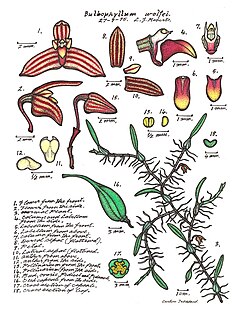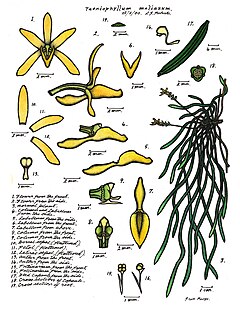
Bulbophyllum wolfei, commonly known as the fleshy snake orchid, is a species of epiphytic or lithophytic orchid with thin, creeping rhizomes, and flattened pseudobulbs each with a single thick, fleshy, dark green leaf and a single cream-coloured flower with dark red stripes. It mostly grows on rainforest trees in tropical North Queensland.

Plectorrhiza, commonly known as tangle orchids, is a genus of three species of flowering plants from the orchid family, Orchidaceae and is endemic to Australia. Orchids in the genus Plectorrhiza are epiphytic or lithophytic herbs with short stems, long, tangled roots, short leathery leaves and small flowers on a short, thin flowering stem. Two species occur in eastern Australia and one is endemic to Lord Howe Island.
Schistotylus purpuratus, commonly known as purple sprites, is the only species in the genus Schistotylus from the orchid family, Orchidaceae. It is a small epiphytic orchid with up to six crowded, linear leaves and up to ten cup-shaped, pale green flowers with purple marking and a mostly white labellum. It grows in rainforest and swampy heath in eastern Australia.
Plectorrhiza erecta , commonly known as the upright tangle orchid, is an epiphytic or lithophytic orchid that has many coarse, cord-like roots, many bright green leaves and up to five yellowish orange, cup-shaped flowers with purplish blotches. It grows close to the ground on fibrous barked plants and only occurs on Lord Howe Island.

Dendrobium bifalce, commonly known as the native bee orchid, is an epiphytic or lithophytic orchid in the family Orchidaceae. It has spindle-shaped pseudobulbs with up to four leathery leaves and up to ten pale green or greenish yellow flowers with purplish markings. It grows on trees and boulders in rainforest in tropical North Queensland, Australia and in New Guinea.
Chiloschista phyllorhiza, commonly known as the white starfish orchid, is a species of leafless epiphytic or lithophytic orchid that forms small clumps with many radiating, flattened green roots. A large number of short-lived, crystalline white, star-shaped flowers with a yellow labellum are arranged along thin, arching flowering stems. It occurs in northern parts of Australia where it grows in rainforest, swamps and near streams.

Luisia tristis, commonly known as the velvet orchid, is a species of epiphytic or lithophytic orchid with wiry stems often forming tangled clumps, cylindrical leaves and flowering stems with up to three green flowers with a dark red to dark maroon labellum. This orchid occurs in tropical Asia, New Guinea, Australia and some islands of the Western Pacific Ocean.

Micropera fasciculata, commonly known as the pale dismal orchid, is a species of epiphytic or lithophytic orchid with wiry stems forming large, tangled clumps. It has stiff, leathery leaves and flowering stems with between ten and twenty cream-coloured flowers with a white labellum. This orchid occurs in New Guinea, Queensland, the Solomon Islands and New Caledonia.

Plectorrhiza brevilabris, commonly known as the small tangle orchid, is an epiphytic or lithophytic orchid endemic to Australia. It has many coarse, wiry roots, between three and nine bright green leaves and up to twenty green, star-shaped flowers with reddish brown markings and a white patch on the labellum. It grows in rainforest on trees, shrubs and occasionally on rocks and occurs on the near coastal ranges of eastern Queensland.

Pomatocalpa macphersonii, commonly known as the blotched bladder orchid, is an epiphytic or lithophytic orchid with thick, cord-like roots, between two and eight dark green, leathery leaves and up to thirty cup-shaped, yellow flowers with red blotches and a white labellum with red blotches. It usually grows on rainforest trees and is found in New Guinea and tropical North Queensland, Australia.

Pomatocalpa marsupiale, commonly known as the branched bladder orchid, is an epiphytic or lithophytic orchid that forms large clumps. It has many thick roots, branched stems, many strap-like, leathery leaves and up to many upward-facing green flowers with a cream-coloured or yellowish labellum. It usually grows on high on rainforest trees and is found between Sulawesi and tropical North Queensland, Australia.
Saccolabiopsis armitii, commonly known as the spotted pitcher orchid, is an epiphytic orchid from the family Orchidaceae. It has a short stem, coarse, wiry roots, between three and six crowded, curved leaves and up to fifty yellowish green flowers with red markings and a white labellum. It usually grows in coastal scrub to rainforest in New Guinea and tropical North Queensland, Australia.
Taeniophyllum muelleri, commonly known as the chain ribbonroot, is a species of leafless epiphytic or lithophytic orchid that usually forms tangled colonies. It has short stems and cylindrical green roots pressed against the substrate on which it is growing. Between five and twelve yellowish green, tube-shaped flowers open one at a time. This orchid occurs in eastern Australia and New Caledonia.

Taeniophyllum malianum, commonly known as the tangled ribbonroot, is a species of leafless epiphytic or lithophytic orchid that forms tangled clumps. It has flattened green roots with irregular white spots and pressed against the substrate on which it is growing. There are up to fifteen fragrant yellow, short-lived flowers with up to three open at the same time. It only occurs in tropical North Queensland and in New Guinea.

Thrixspermum congestum, commonly known as the cupped hairseed, is an epiphytic or lithophytic orchid that forms small clumps with many thin roots, up to fifteen leathery leaves and many star-shaped white or cream-coloured flowers. This orchid occurs from Papuasia to northern Australia.
Thrixspermum platystachys, commonly known as the starry hairseed, is an epiphytic or lithophytic orchid that forms untidy clumps with many tangled, wiry roots, up to ten stiff, leathery leaves and many star-shaped, cream-coloured flowers with an orange and white labellum. This orchid occurs from Papuasia to northern Queensland.

Trachoma speciosum, commonly known as the showy spectral orchid, is an epiphytic or lithophytic orchid that forms clumps with many thick, cord-like roots, between four and eight thick, leathery leaves and many short-lived, cream-coloured flowers with an orange and white labellum. This orchid occurs in tropical North Queensland.
Bryobium dischorense, commonly known as the spotted urchin orchid, is an epiphytic or lithophytic clump-forming orchid that has fleshy, oval pseudobulbs, each with a single thin leaf and between four and eight cup-shaped, cream-coloured or whitish flowers with red spots. This orchid occurs in New Guinea and Queensland.
Bryobium eriaeoides, commonly known as the brittle urchin orchid, is an epiphytic or lithophytic clump-forming orchid that has fleshy, green pseudobulbs, each with two leaves and between three and twelve cup-shaped white to purplish flowers but that sometimes remain closed. This orchid occurs in New Guinea and Queensland.

Bryobium queenslandicum, commonly known as the dingy urchin orchid, is an epiphytic or lithophytic clump-forming orchid that has cylindrical, fleshy green pseudobulbs, each with two leaves and between three and twelve small, self-pollinating, cream-coloured or pinkish flowers. This orchid only occurs in tropical North Queensland.












